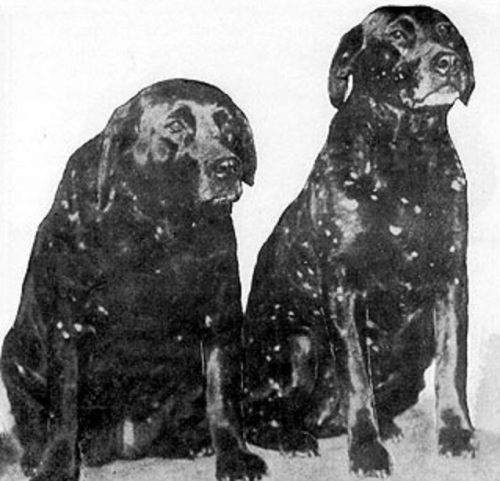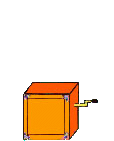
In the course of rummaging around the background of different breeds, we often stumble across information we think anyone would find fascinating, not just self professed dog nerds. We think the Hailstone Labrador Retriever is one such topic, and we share it here in the spirit of education.
Hailstone Labs were black dogs spotted with white flecks, a “reverse Dalmatian,” if you will. Back in the day, some thought they reflected very old, and very true water retriever strains of the breed that may have originated in the Solway coast area of Scotland. One such dog was even shown at Crufts by the Angerton keeper, Mr. Dawson, and perhaps more startling was that the dog had won several first place prizes. One of the most distinguished Labrador Retriever people of the day, Lady Lorna, Countess of Howe, and co-supporter of the founding of the Labrador Club in England, went into the ring at Crufts and patted the dog in approval. She herself qualified no fewer than 24 dogs for the Retriever Championship between 1920 and 1936 and won it three times.

Thanks to a reader, we can share that this photo comes from Mary Roslin Williams’ book, but is uncredited.
In the book, “Advanced Labrador Breeding” published in 1988 by Mary Roslin Williams, a paragraph appears in the section on color, and we’re uncertain if the author is quoting someone else, or is referring to herself, but it reads, “Lady Howe herself told me if I ever bred one [with Hailstone marking] to keep it because they always had the right coat, type and characteristics. However when I did breed one I found it was regarded with the greatest suspicion by other breeders and that the modern judges would not consider it, and as the Standard says that the colour should not be of flecked appearance much as I liked it I sold it as a pet and have regretted my weakness ever since. ‘They’ were wrong and I know I should have kept it.” Later on in the same chapter, there is reference to “Snowstorm” Labradors with big white flakes, also from the Solway.
Since the breed was first recognized in 1903, a number of decidedly not-to-standard-colors have vexed the Labrador Retriever community. The breed standard in virtually all registries and breed clubs around the world is clear: Labrador Retriever coat colors are black, yellow and chocolate. End of story. Any other color or a combination of colors is a disqualification, and the only mention of a spot is that a small white one on the chest is “ok,” but not desirable.
Our first impression upon coming across the Hailstone Lab is that it was a thing of the past, but breed forums – particularly ones  frequented by non-fanciers – are marvelous places to find shared experiences, and we found a thread that when pulled, took us to a relatively recent photograph of a “hailstone” Lab puppy posted by her baffled owner, a second generation Lab owner. Genetics can throw Jack-in-the-box surprises at us!
frequented by non-fanciers – are marvelous places to find shared experiences, and we found a thread that when pulled, took us to a relatively recent photograph of a “hailstone” Lab puppy posted by her baffled owner, a second generation Lab owner. Genetics can throw Jack-in-the-box surprises at us!
Image: Labrador Retriever in the Sugar Skull Style by Robin Arthur
https://robiniart.com/
www.facebook.com/robiniart
instagram.com/robiniart

The coloring might confuse some, but that expression on the one on the right is all Lab!
The photo is from the book Advanced Labrador Breeding but does not have a photographer listed or any mention of who they are. The “I” is Mary Roslin Williams. I have the book and it has som interesting information. The quote is on page 113 of the original 1988 edition.
This is incredibly helpful, Melinda. Thank you so much for taking the trouble to share this information with us! We did wonder about that photograph, and especially about that quote because as far as we could tell, there was some forty years + between the Lady’s day and the author’s book.
Certainly still a Labrador and really it doesn’t matter about the hailstone spots or the snowflakes they are still the lovable Labrador.
No argument from us, Helen. No doubt these dogs are marvelous companions and hunting dogs. We leave any debate about color, markings, etc., to the people invested in the breed – the owners and breeders – but feel it’s a disservice to leave out the fact that they can’t be shown in a conformation ring. Breeding them, now that’s an interesting question best left to a geneticist.